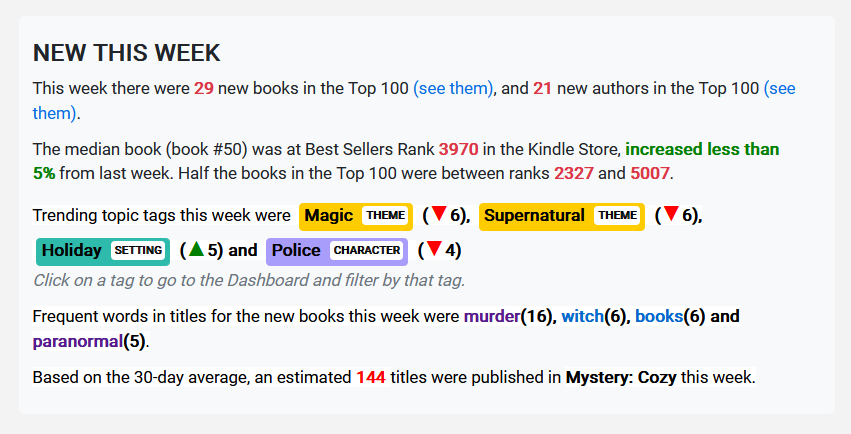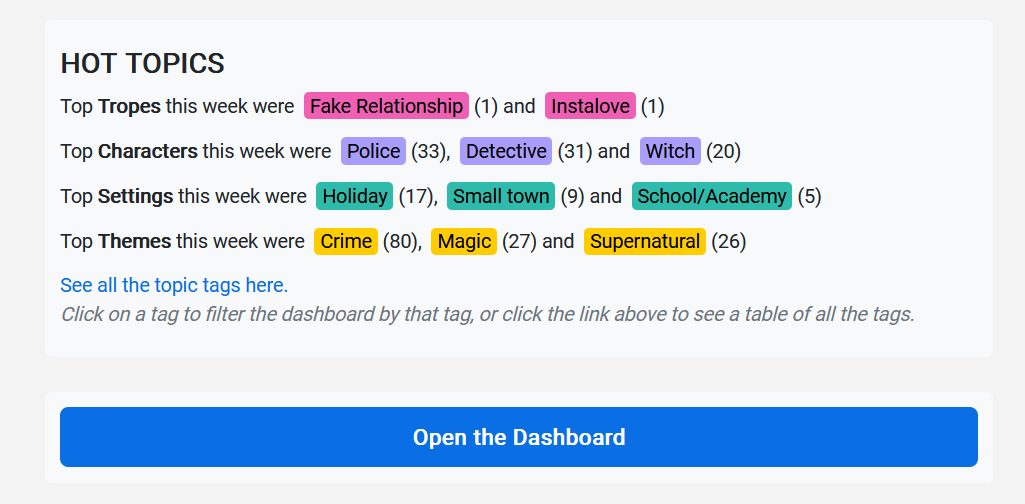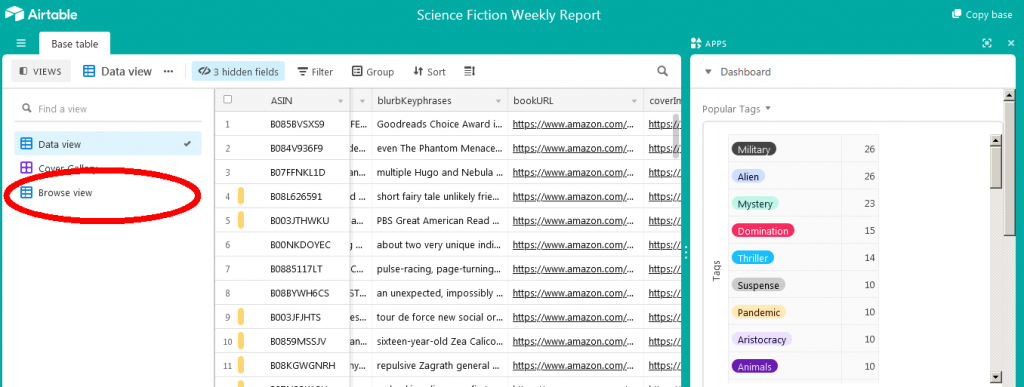This is a step-by-step guide to using the Kindletrends newsletter to do genre research in the Kindle Store. Understanding a genre you want to write in is one of the most important elements of being an author. There are lots of different theories about about what a genre is, and how they relate to each other, and you’ll derive your own theories as you do your own research.
Also, there are a lot of very smart people who have written about this topic; I will be referencing their work, and encouraging you to go and read it as well. The approach I’ll be describing here is one of many, although I think they are complementary, not contradictory; you’ll find that things I suggest here will fit in well with other ‘how to research’ material you read elsewhere.
Four parts of research
I’ve chosen to divide research up into four parts, representing four different areas I think you need to master to be on top of your genre. They start with the ‘innermost’ and most fundamental one – the content of your book – and work outwards through blurbs, covers and genre mechanics. None is more important than any other, and I suggest tackling them in this order so you can see how each influences the other.
1. Content: what’s in your book
2. Blurbs: what’s on the buying page of your book
3. Covers: what’s on the front of your book
4. Mechanics: everything else about your genre that isn’t your book
In each section I’ll explain ways you can use Kindletrends and other tools to make the most of your research. I’ll also provide links to other resources that have helped me, and to authors and writers who I think are really accomplished in this area.
If you have questions, you can always email me here and I’ll be happy to help.
Part One: Content
We’re starting with content because I think understanding genre content is the most important part of being a successful genre fiction writer. You don’t have to copy it, and you don’t you don’t have to be bound by it, but you do have to understand it.
The content of your story is what you are delivering to the reader for their money; promising it through the cover, developing that promise in the blurb, and then delivering when they decide to buy your book. This means that understanding the relationship between story elements in a genre, and the reader expectations they fulfil, is one of the best ways you can spend your research time. This is always hard work, but Kindletrends makes it easier by letting you sort and filter books by type and content, so you can quickly see major divisions in a category, and pull out specific books of interest.
Getting Started
To get started understanding the content of a genre, let’s look at a Kindletrends newsletter for a category. We’ll cover some of this material again in Part Four: Mechanics, but it’s also important here to get a basic idea of how and why books might differ in your genre.

First, look at how many new books there are in the Top 100 for a category. If there are a lot of new books, that shows that the category is pretty active, and new books are coming out every month. This might mean that it’s easier to get into the top-selling books, but it might also mean that you need to publish more frequently, and advertise more, to stay there.
On the other hand, a low number of new books might mean that you don’t have to publish as frequently in this category, but it might be harder to break into. You can also watch this figure from week to week and month to month, to see if the category is getting more, or less, busy.
Next, take a note of how many books are in KU, and how many are wide, as well as how many are traditionally published. When you come to pick out books to read and to study, keep in mind that these books may be aimed at different markets – so if you see differences between them, this may be the reason.
To get a broad picture of what’s popular in a category, take a look at the trending topic tags:

We’ll use the Dashboard to pull out books with those tags, so you can study them. To open the dashboard, click the button here below the Hot Topics section:

When you open the dashboard, you’ll see a list of the most popular tags on the right. Choose a couple that are interesting to you, and note them down. Now let’s go to the Browse view, by clicking here, on the left:

In the Browse view, you can see the covers and blurbs, and browse them. Click on the ‘Filter’ option at the top to filter the list by the tags you noted down earlier. You can also click the Close button on the right (the little ‘x’) to hide the charts for a little more space.
When you’ve narrowed down a list of books you want to read, click here to show the full record for a book:

In the full record, you can read the complete blurb, check the topic tags and go straight to the Kindle Store page for the book. Choose a couple of books to read that look appealing to you, and that you would like to have written. Make notes on why those books look appealing to you, and what you like about them. As you read these books, your experience and your opinions will change, so it’s important to record your initial observations.
Work through the books paying attention to the major story and style elements; make notes on what you read, where it happens in the book, and how each element is linked to the others around it. Kindletrends’ topic tags will give you a basic guide to what’s in the book, but to understand stories at a deeper level, plotting and craft books will really help; I list a few in the ‘Further Reading’ section below.
To keep notes, you can copy records out of the Dashboard and paste them into another document, or you can sign up for a free Airtable account and click the ‘copy base’ button on the top right-hand side of the Dashboard to copy the whole Top 100 to your own account, then add whatever notes you want.
Next, go back to the Kindle Store page for the book (it’s in the Dashboard as well) and read the reviews, both positive and negative. If you see a common element that readers liked or didn’t like about the book, note it down. The details of what readers say are often not as important as the elements about which they say it. A story element which is memorable will be commented upon in a review; so for each relevant comment, think about what would cause a reader to feel that way.
When you’ve worked through a few different books, compare your notes on them. Which elements are the same, and which differ between books? How do the similar or different elements affect the plot? Which elements are commented on – positively or negatively – by readers?
The more books in a genre you read, the more you’ll get an idea of the relationship between story elements and reader expectations; how those expectations are established and then fulfilled by the story in a satisfying way.
In the following sections, we’ll return to the notes you’ve made here, and add to them as you look at how the blurb and cover both work to set reader expectations, and which story elements specifically relate to them.
Further reading:
There are many good plotting and craft books and resources, and I will only recommend a few, from least cost and time to most. I encourage you to read a lot of different perspectives about plotting and craft, and take the parts which work for you.
- If you have no money and no time, this comment from /u/smutisafunnyword on Reddit is a very effective how-to summary, and has heavily influenced my own approach to research.
- Jami Gold has many useful resources for writers, and her beat sheets are an excellent (free) synopsis (https://jamigold.com/2013/09/are-beat-sheets-intimidating-cut-through-the-clutter/).
- Romancing the Beat: (https://www.romancingthebeat.com/) Still the most accessible plotting book ever written. Even if you have no interest in romance, this is valuable; romance stories are ingrained into us, and so studying them is a way to get into plotting.
- Save the Cat! Writes a Novel (https://www.jessicabrody.com/books/non-fiction/save-cat-writes-novel/about/). This is a more traditional story-structure method and may take a little longer to work through, but is one of the most common you’ll see mentioned.

